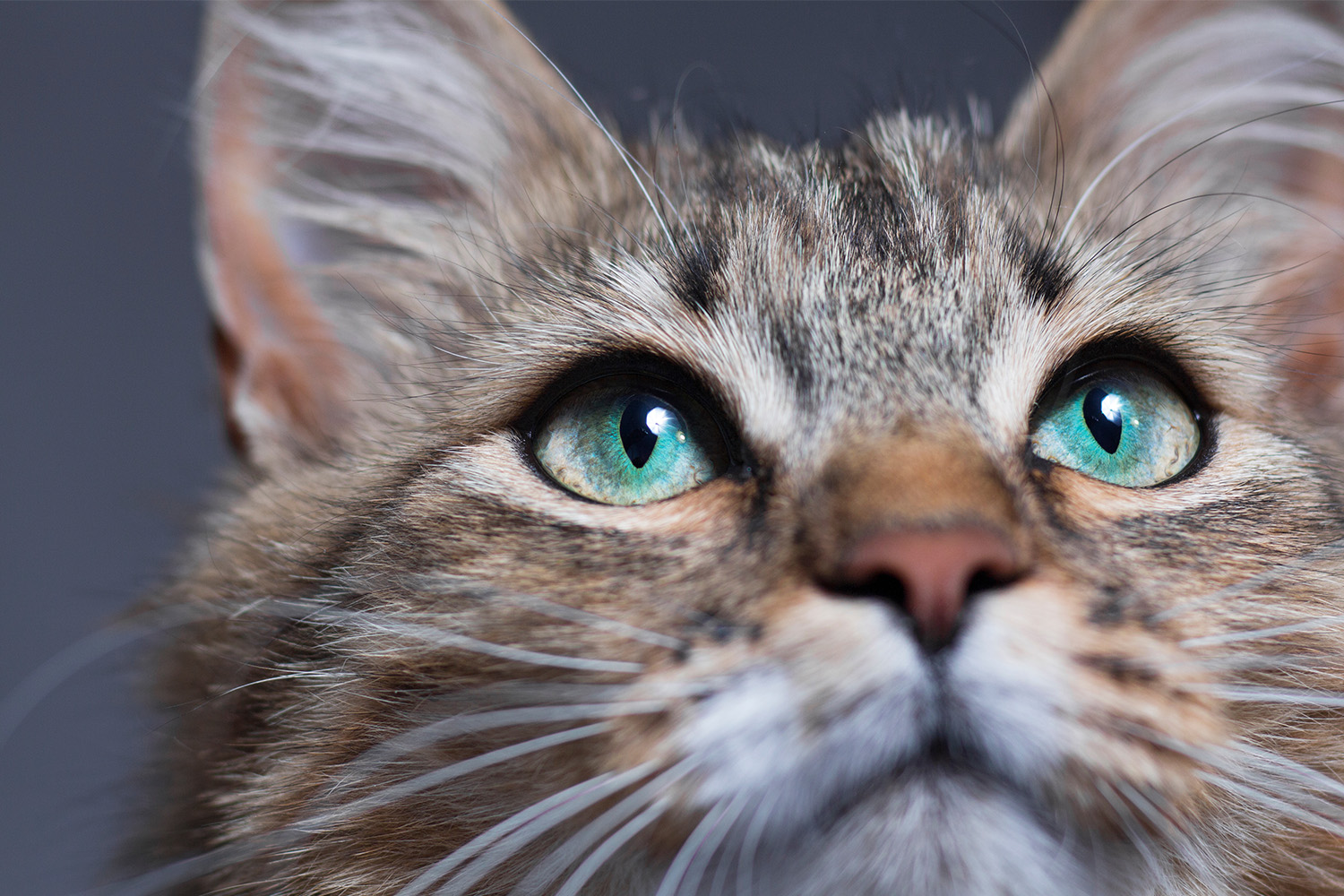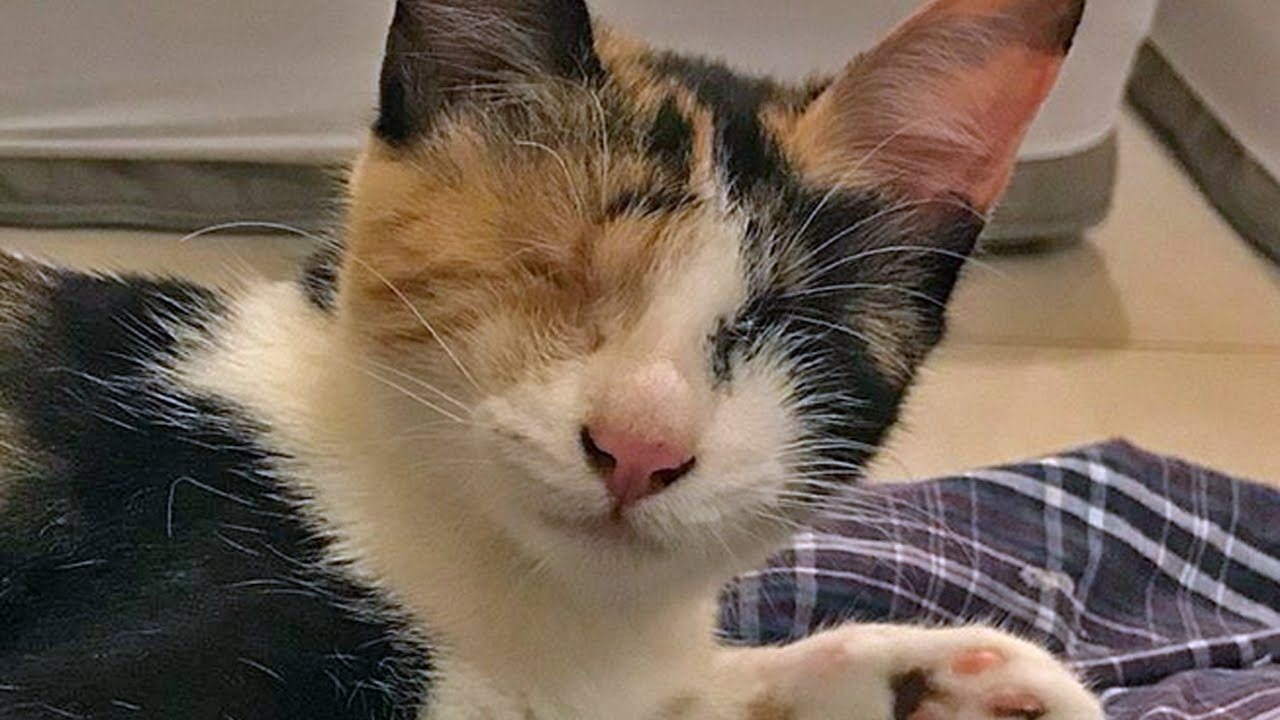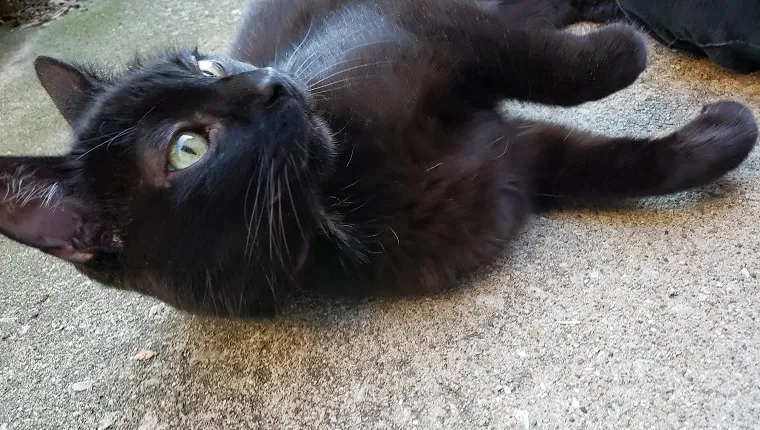What We Know About Can Cats See Color?
Cats Have Limited Color Vision

Cats have a unique visual system that allows them to navigate their surroundings, but it is different from humans. One common question is whether cats can see color or are they colorblind.
The answer to this question depends on how we define “color vision”. Humans have trichromatic vision, which means we have three types of cones in our retina that detect red, green, and blue light. This allows us to perceive a wide range of colors. Cats, on the other hand, are dichromats.
Dichromats have only two types of cones in their retina, which means they can see blues and yellows, but not reds and greens. They also tend to see the world in shades of yellow, blue, and gray.
So, are cats colorblind? Not exactly. They can’t perceive colors that we do, but it’s more accurate to say they have limited color vision or are color restricted. This means they see the world in a different way than humans and other animals with trichromatic vision.
Cats’ limited color vision is thought to be an adaptation for their hunting behavior. They use their sense of smell and hearing to track prey, and their visual system is optimized for detecting movement and contrast rather than seeing colors.
Another factor that affects cats’ color vision is the structure of their eyes. Cats have a reflective layer in the back of their eye called the tapetum lucidum, which helps them see better in low light conditions. However, this layer can also affect how they perceive colors.
Cats are most sensitive to blue and violet light, which means that these colors will stand out more to them than other colors. However, their sensitivity to red and green light is much lower, which means that these colors may appear dull or washed out.
So, while cats can’t see colors in the same way as humans, they do have a unique visual system that allows them to navigate their surroundings effectively. Their limited color vision is just one aspect of their fascinating and highly specialized sensory abilities.
Cats have dichromatic vision, which means they can see blues and violets but struggle with reds and greens.
Cats have dichromatic vision, a type of color blindness that affects their ability to perceive colors.
This means they can see blues and violets, which are parts of the spectrum that are relatively easy for them to distinguish.
However, cats struggle with reds and greens, which fall into a range of wavelengths that is difficult for them to see.
The dichromatic vision in cats is due to the structure of their retina, specifically the type of cones present in their eyes.
Cats have only two types of cones, whereas humans have three, allowing us to perceive a wider range of colors including reds and greens.
While it’s true that cats can’t see color like we do, they are not completely colorblind.
They can still distinguish between different shades of light and dark, and their dichromatic vision is sufficient for navigating their surroundings and hunting prey.
In fact, many experts believe that cats’ visual abilities have evolved to prioritize sensitivity to movement and changes in brightness over color perception.
This means that cats are highly attuned to detecting subtle changes in light and shadow, which can be useful for stalking small prey or avoiding predators.
So while cats may not see the world in the same vibrant colors as we do, their visual system is specialized for its own unique set of tasks and challenges.
In many ways, a cat’s ability to navigate the world without relying on color vision is just one example of their remarkable adaptability and survival skills.
The Science Behind Cat Color Perception
How the Eye Works
The human eye is an incredibly complex organ that allows us to perceive and interpret the world around us. At its center is the retina, a layer of light-sensitive cells called photoreceptors. These photoreceptors are responsible for detecting the various wavelengths of light that enter the eye and sending signals to the brain for interpretation.
The question of whether cats can see color or if they are colorblind has been debated among animal lovers and scientists for years. While it’s true that humans have trichromatic vision, which means we have three types of cones that allow us to detect red, green, and blue light, research suggests that cats have dichromatic vision.
Cats have two types of cones that are sensitive to different ranges of wavelengths: one for blue-violet light and the other for yellow-green light. This is why cats tend to see the world in shades of blue and yellow, with reds and greens appearing more muted or washed out. However, this does not mean that cats are completely colorblind.
Cats can still detect a range of colors, but their vision is limited compared to humans. They have excellent low-light vision, which is why they are often able to see well in dimly lit environments. This is due to the reflective layer in the back of their eyes called the tapetum lucidum.
The tapetum lucidum acts like a mirror, reflecting light back onto the photoreceptors and increasing the amount of light that reaches the retina. This allows cats to see better at night or in low-light conditions than humans do. However, it also means that when you shine a flashlight into a cat’s eyes, they will often reflect it back out due to this reflective layer.
So while cats may not be able to see colors as vividly or with the same range as humans, their dichromatic vision and low-light sensitivity make them incredibly adept at navigating the world around them. Whether or not they are colorblind is a matter of interpretation, but it’s clear that their unique visual abilities serve them well in their natural environment.
Some key differences between human and cat vision include:
Cats have dichromatic vision while humans have trichromatic vision
Cats are better at seeing blues and yellows, but less sensitive to reds and greens
Cats can see better in low light due to the tapetum lucidum
Cats have a wider field of vision than humans (about 200° compared to 180°)
Cats are less sensitive to movement and more sensitive to contrast
Overall, while cats may not be able to see colors with the same range or intensity as humans, their unique visual abilities make them incredibly well-suited to their natural environment. Whether you view them as colorblind or simply having a different type of vision, it’s clear that cats are amazing animals that continue to fascinate and inspire us.
In cats, the retina has two types of cones that are sensitive to different parts of the visual spectrum: one for blue light (400500 nanometers) and another for yellowgreen light (500600 nanometers).

The ability of cats to see color is a common topic of debate, with some people believing that they are completely colorblind and others thinking that they can see colors, albeit not as vividly or with the same range as humans.
Cats have what’s called dichromatic vision, which means that they have two types of cones in their retina that allow them to detect different parts of the visual spectrum. Specifically, one type of cone is sensitive to blue light (400-500 nanometers) and another is sensitive to yellow-green light (500-600 nanometers).
This dichromatic vision is often compared to humans’ trichromatic vision, which has three types of cones that can detect a wider range of colors. The difference in color perception between cats and humans is largely due to the fact that cats lack the cones that are sensitive to red light (600-700 nanometers).
As a result, cats tend to see the world in shades of yellow, blue, and gray, but may struggle to distinguish between different hues or nuances of color. This can make it difficult for them to identify objects or colors in low-light environments or in situations where visual cues are subtle.
However, this does not mean that cats are completely colorblind! They can still see the world around them and respond to changes in light and shadow, which allows them to navigate their environment with ease. Their lack of color vision is simply a difference between how they perceive color compared to humans.
It’s worth noting that some research suggests that cats may have a different type of color vision than dogs or other mammals, which could be an adaptation to their nocturnal lifestyle and the need to see in low-light conditions. Regardless, the fact remains that cats are not as sensitive to color as humans are, but they still have a unique and effective way of seeing the world.
The Implications of Limited Color Vision
Cats and Their Environment
Cats are often misunderstood when it comes to their ability to see colors. While it’s common to think that cats, like dogs, are colorblind and can only see in black and white, this isn’t entirely accurate.
The truth is, cats have limited color vision compared to humans and some other animals, but they’re not completely colorblind either. Cats have what’s called dichromatic vision, which means they have two types of cones that are sensitive to different parts of the visual spectrum.
Cats can see colors in the blue and yellow range, but not reds and greens. This is because their cone cells are sensitive to wavelengths in the 450-495 nanometer range (blue), as well as the 570-600 nanometer range (yellow).
This limited color vision doesn’t mean cats have poor eyesight or that they’re unable to perceive visual cues. On the contrary, cats rely heavily on their eyesight and spatial awareness to navigate and hunt.
Research suggests that cats’ brains process color information differently than humans do. For example, a study found that when shown two identical images with the same gray background but different colors (blue or yellow), cats preferred the image with the blue color. This suggests that cats may use their limited color vision to distinguish between different objects and environments.
Cats’ ability to see colors may be more related to motion and contrast than actual colors themselves. In other words, a cat may not care about the specific color of an object as much as its movement or texture.
This has important implications for cat owners who want to create stimulating environments for their feline friends. Instead of relying on bright colors, cat toys and objects that move, rotate, or provide tactile stimulation are more likely to engage cats’ natural hunting instincts.
While cats can’t see a wide range of colors, they are highly sensitive to movement and changes in brightness.
Cats have a unique visual system that allows them to see the world differently than humans do, but it’s not necessarily because they are colorblind. While it’s true that cats can’t see a wide range of colors like we do, their eyes are highly sensitive to movement and changes in brightness.
So, what exactly does this mean? Let’s break it down:
Cat Color Vision: A Quick Primer
The cat’s retina contains two types of cones that allow them to see colors. However, these cones are sensitive to different parts of the visual spectrum than human cones.
While humans have trichromatic vision (three cones for red, green, and blue), cats are dichromats (two cones). This means they can’t see subtle differences between shades of color that we take for granted.
What Do Cats See?
The exact range of colors that cats can see is still a topic of debate. Some research suggests they may be able to see blues and violets, but struggle with reds and greens.
Cats are Exceptionally Sensitive to Movement
This is where the cat’s visual system shines (pun intended). Their eyes are incredibly sensitive to movement, which helps them catch prey or detect potential threats in their environment.
Cats have a high concentration of rods in their retina, which are more sensitive to movement and low light levels than cones. This makes them excellent at detecting the slightest changes in brightness and shadow.
Why Do Cats Prefer Darkness?
This sensitivity to movement and brightness explains why cats often prefer dimly lit environments. In their natural habitat, hunting typically occurs at dawn or dusk when light levels are low.
The reduced light helps them conserve energy while stalking prey, making them more efficient predators. It also reduces glare from sunlight, allowing them to focus on potential prey more effectively.
Conclusion
Cats are not colorblind, but their visual system has evolved to prioritize movement and brightness over fine color differentiation. This unique combination of traits makes them highly effective predators in their natural environment, even if they don’t share our love of colorful sunsets.
Do Cats Have Any Advantages?
Hunting and Adaptation

Cats are often thought to be colorblind, but the reality is more complex. While it’s true that cats don’t see colors as vividly as humans do, they can still perceive a range of hues and shades.
Here’s what we know about feline vision: Cats have a type of cone cell in their retina called long-wavelength cones (L-cones). These L-cones are sensitive to blue light and allow cats to see blues and violets, but not reds or greens.
The reason cats can’t see reds and greens is that these colors are perceived by medium- and short-wavelength cone cells (M-cones and S-cones), which are absent in cats. Mice, on the other hand, have a similar visual system to humans and can see all colors of the visible spectrum.
However, don’t assume that because cats lack red vision, they’re completely colorblind. While it’s true that they may have difficulty distinguishing between certain hues, their brains are highly adaptable. Through experience and learning, cats develop a keen sense of object recognition and can detect subtle changes in color.
This is where the idea of “adaptation” comes in. You see, cats don’t rely solely on visual cues to navigate their environment; they also use other senses like smell, hearing, and whisker sensitivity. Their highly developed brain regions that process sensory information help them create a comprehensive picture of their surroundings.
Now, let’s talk about hunting and how color vision impacts this behavior. While cats might not see colors as humans do, their visual system is optimized for detecting movement and changes in brightness – exactly what they need to catch prey!
Hunters with exceptional eyesight can spot tiny prey at distances of up to 40 feet away; they’re incredibly skilled at tracking their quarry through shadows and dappled sunlight.
It’s worth noting that, while color vision may not be essential for hunting in the wild, cats have developed unique adaptations that compensate for any perceived lack. Their sharp hearing, powerful whiskers, and instinctual behavior all contribute to making them formidable predators.
In summary, the claim of colorblindness is an oversimplification; cats do see colors – albeit differently than humans – but their brains are incredibly adept at compensating through adaptation, sensory integration, and learning.
Cats’ limited color vision is often offset by their exceptional lowlight vision, which helps them hunt at night.
Cats are known to have a unique visual system that sets them apart from humans and other animals. While they can see colors, their color vision is limited compared to what we experience. In fact, cats have dichromatic color vision, which means they have two types of cones in their retina that are sensitive to different parts of the visual spectrum.
This limited color vision is often referred to as color blindness, but it’s more accurate to say that cats see colors differently than humans do. They can distinguish between blues and violets, as well as greens and yellows, but they have difficulty distinguishing reds from greens or other similar colors.
Despite their limited color vision, cats are highly effective hunters, thanks in large part to their exceptional lowlight vision. This is due to the reflective layer called the tapetum lucidum in the back of their eyes, which reflects light back onto the retina and enhances sensitivity in dim light. In addition to this, cats have a larger pupil diameter than humans, allowing more light into the eye.
Together, these adaptations enable cats to navigate and hunt in low-light conditions with ease. They can see movement and changes in brightness much more effectively than humans, which makes them skilled predators even at night or in dimly lit environments. It’s this unique combination of limited color vision and exceptional lowlight sensitivity that allows cats to thrive as nocturnal hunters.
- Best Dun & Bradstreet (DNB) Alternatives for 2025 - April 19, 2025
- Best 6sense Alternatives for 2025 - April 18, 2025
- Best Instantly.ai Alternatives for 2025 - April 18, 2025



